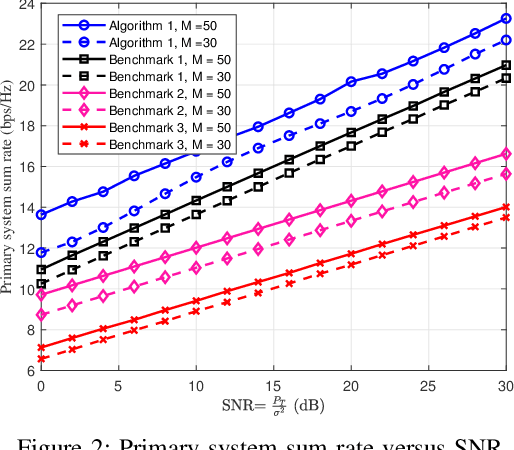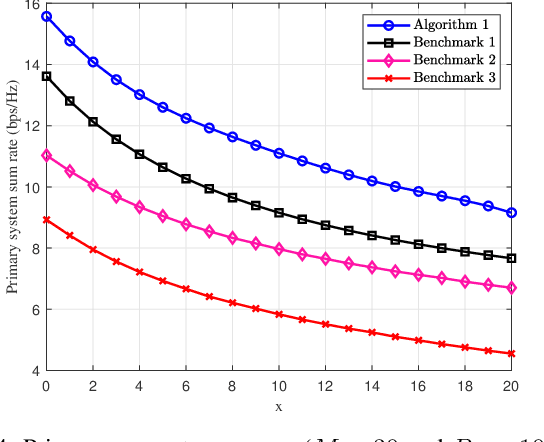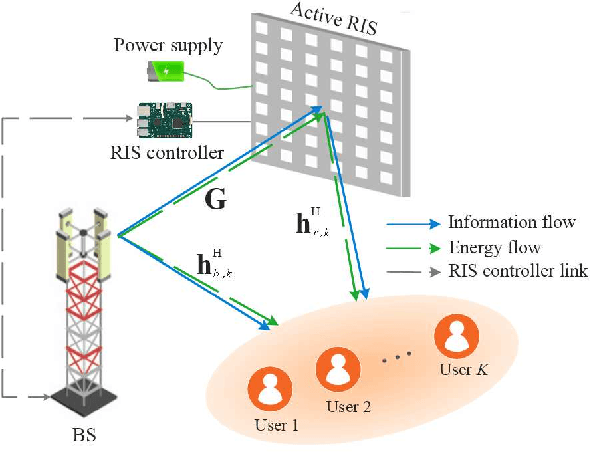Sanjeewa Herath
RIS-Assisted Energy Harvesting Gains for Bistatic Backscatter Networks: Performance Analysis and RIS Phase Optimization
Sep 18, 2023Abstract:Inexpensive tags powered by energy harvesting (EH) can realize green (energy-efficient) Internet of Things (IoT) networks. However, tags are vulnerable to energy insecurities, resulting in poor communication ranges, activation distances, and data rates. To overcome these challenges, we explore the use of a reconfigurable intelligent surface (RIS) for EH-based IoT networks. The RIS is deployed to enhance RF power at the tag, improving EH capabilities. We consider linear and non-linear EH models and analyze single-tag and multi-tag scenarios. For single-tag networks, the tag's maximum received power and the reader's signal-to-noise ratio with the optimized RIS phase-shifts are derived. Key metrics, such as received power, harvested power, achievable rate, outage probability, bit error rate, and diversity order, are also evaluated. The impact of RIS phase shift quantization errors is also studied. For the multi-tag case, an algorithm to compute the optimal RIS phase-shifts is developed. Numerical results and simulations demonstrate significant improvements compared to the benchmarks of no-RIS case and random RIS-phase design. For instance, our optimal design with a \num{200}-element RIS increases the activation distance by \qty{270}{\percent} and \qty{55}{\percent} compared to those benchmarks. In summary, RIS deployment improves the energy autonomy of tags while maintaining the basic tag design intact.
NOMA-Assisted Symbiotic Backscatter: Novel Beamforming Designs Under Imperfect SIC
Feb 18, 2023Abstract:Optimal beamforming designs under imperfect successive interference cancellation (SIC) decoding for a symbiotic network of non-orthogonal multiple access (NOMA) primary users and a secondary ambient tag have been lacking. We address that issue here. The primary base station (BS) serves NOMA users and a passive tag simultaneously in this network. We develop two transmit beamforming designs to meet the user and tag requirements while mitigating the effect of imperfect SIC. Specifically, we design optimal BS transmit beamforming and power allocation to either maximize the weighted sum rate of NOMA users and the tag or minimize the BS transmit power under the minimum rate requirements while satisfying the tag minimum energy requirement. Because both these problems are non-convex, we propose algorithms using alternative optimization, fractional programming, and semi-definite relaxation techniques. We also analyze their computational complexity. Finally, we present extensive numerical results to validate the proposed schemes and to show significant performance gains while keeping the tag design intact. For example, the proposed digital beamforming increases the harvested power and data rate by 2.16e3 % and 314.5 % compared to random beamforming.
IRS-Enabled Backscattering in a Downlink Non-Orthogonal Multiple Access System
Sep 02, 2022



Abstract:Intelligent reflecting surface (IRS)-enabled backscatter communications can be enabled by an access point (AP) that splits its transmit signal into modulated and unmodulated parts. This letter integrates non-orthogonal multiple access (NOMA) with this method to create a two-user primary system and a secondary system of IRS data. Considering the decoding order, we maximize the rate of the strongest primary user by jointly optimizing the IRS phase shifts, power splitting (PS) factor at the AP, and NOMA power coefficients while guaranteeing the quality of service (QoS) for both weak user and IRS data in the primary and secondary systems, respectively. The resulting optimization problem is non-convex. Thus, we split it into three parts and develop an alternating optimization (AO) algorithm. The advantage is that we derive closed-form solutions for the PS factor and NOMA power coefficients in the first two parts. In the third part, we optimize the phase shifts by exploiting semi-definite relaxation (SDR) and penalty techniques to handle the unit-modulus constraints. This algorithm achieves substantial gains (e.g., 40--68%) compared to relevant baseline schemes.
Multiuser MISO PS-SWIPT Systems: Active or Passive RIS?
Jun 28, 2022


Abstract:Reconfigurable intelligent surface (RIS)-based communication networks promise to improve channel capacity and energy efficiency. However, the promised capacity gains could be negligible for passive RISs because of the double pathloss effect. Active RISs can overcome this issue because they have reflector elements with a low-cost amplifier. This letter studies the active RIS-aided simultaneous wireless information and power transfer (SWIPT) in a multiuser system. The users exploit power splitting (PS) to decode information and harvest energy simultaneously based on a realistic piecewise nonlinear energy harvesting model. The goal is to minimize the base station (BS) transmit power by optimizing its beamformers, PS ratios, and RIS phase shifts/amplification factors. The simulation results show significant improvements (e.g., 19% and 28%) with the maximum reflect power of 10 mW and 15 mW, respectively, compared to the passive RIS without higher computational complexity cost. We also show the robustness of the proposed algorithm against imperfect channel state information.
 Add to Chrome
Add to Chrome Add to Firefox
Add to Firefox Add to Edge
Add to Edge